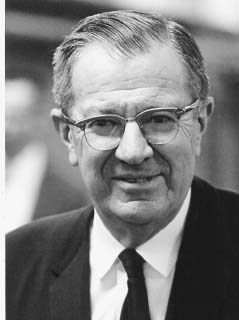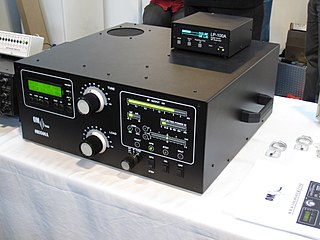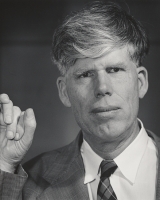
A triode is an electronic amplifying vacuum tube consisting of three electrodes inside an evacuated glass envelope: a heated filament or cathode, a grid, and a plate (anode). Developed from Lee De Forest's 1906 Audion, a partial vacuum tube that added a grid electrode to the thermionic diode, the triode was the first practical electronic amplifier and the ancestor of other types of vacuum tubes such as the tetrode and pentode. Its invention helped make amplified radio technology and long-distance telephony possible. Triodes were widely used in consumer electronics devices such as radios and televisions until the 1970s, when transistors replaced them. Today, their main remaining use is in high-power RF amplifiers in radio transmitters and industrial RF heating devices. In recent years there has been a resurgence in demand for low power triodes due to renewed interest in tube-type audio systems by audiophiles who prefer the sound of tube-based electronics.

A vacuum tube, electron tube, valve, or tube, is a device that controls electric current flow in a high vacuum between electrodes to which an electric potential difference has been applied.
A tetrode is a vacuum tube having four active electrodes. The four electrodes in order from the centre are: a thermionic cathode, first and second grids, and a plate. There are several varieties of tetrodes, the most common being the screen-grid tube and the beam tetrode. In screen-grid tubes and beam tetrodes, the first grid is the control grid and the second grid is the screen grid. In other tetrodes one of the grids is a control grid, while the other may have a variety of functions.

Frederick Emmons Terman was an American professor and academic administrator. He was the dean of the school of engineering from 1944 to 1958 and provost from 1955 to 1965 at Stanford University. He is widely credited as being the father of Silicon Valley.

A beam tetrode, sometimes called a beam power tube, is a type of vacuum tube or thermionic valve that has two grids and forms the electron stream from the cathode into multiple partially collimated beams to produce a low potential space charge region between the anode and screen grid to return anode secondary emission electrons to the anode when the anode potential is less than that of the screen grid. Beam tetrodes are usually used for power amplification, from audio frequency to radio frequency. The beam tetrode produces greater output power than a triode or pentode with the same anode supply voltage. The first beam tetrode marketed was the Marconi N40, introduced in 1935. Beam tetrodes manufactured and used in the 21st century include the 4CX250B, KT66 and variants of the 6L6.

A pentode is an electronic device having five electrodes. The term most commonly applies to a three-grid amplifying vacuum tube or thermionic valve that was invented by Gilles Holst and Bernhard D.H. Tellegen in 1926. The pentode was developed from the screen-grid tube or shield-grid tube by the addition of a grid between the screen grid and the plate. The screen-grid tube was limited in performance as an amplifier due to secondary emission of electrons from the plate. The additional grid is called the suppressor grid. The suppressor grid is usually operated at or near the potential of the cathode and prevents secondary emission electrons from the plate from reaching the screen grid. The addition of the suppressor grid permits much greater output signal amplitude to be obtained from the plate of the pentode in amplifier operation than from the plate of the screen-grid tube at the same plate supply voltage. Pentodes were widely manufactured and used in electronic equipment until the 1960s to 1970s, during which time transistors replaced tubes in new designs. During the first quarter of the 21st century, a few pentode tubes have been in production for high power radio frequency applications, musical instrument amplifiers, home audio and niche markets.
Charles Vincent Litton Sr. (1904–1972) was an engineer and inventor from the area now known as Silicon Valley.
Vacuum tubes produced in the former Soviet Union and in present-day Russia carry their own unique designations. Some confusion has been created in "translating" these designations, as they use Cyrillic rather than Latin characters.
Oskar Heil was a German electrical engineer and inventor. He studied physics, chemistry, mathematics, and music at the Georg-August University of Göttingen and was awarded his PhD in 1933, for his work on molecular spectroscopy.
Rogers Vacuum Tube Company was founded as the Standard Radio Manufacturing Corporation in 1925 by Edward Rogers (1900–1939) to sell Rogers "Batteryless" radios using vacuum tube technology. It was later renamed Rogers Majestic Corporation Limited when Rogers merged his company with Majestic Corporation of Chicago in 1928. The new company controlled Rogers Radio Tube Company and Rogers Batteryless Radio Company. Joseph Elsworth Rogers (1898–1960), brother of Edward Rogers, was an important member of the company and served as vice-president until 1939, and then as head from 1939 to 1960.

A valve RF amplifier or tube amplifier (U.S.) is a device for electrically amplifying the power of an electrical radio frequency signal.
Machlett Laboratories was a Northeastern United States-based company that manufactured X-ray and high-power vacuum tubes. Machlett was a large producer of the tubes and developed accessories to be used with them as well.
Varian Associates was one of the first high-tech companies in Silicon Valley. It was founded in 1948 by Russell H. and Sigurd F. Varian, William Webster Hansen, and Edward Ginzton to sell the klystron, the first vacuum tube which could amplify electromagnetic waves at microwave frequencies, and other electromagnetic equipment. Varian Associates split into three companies in 1999: Varian Medical Systems, Varian, Inc. and Varian Semiconductor.

CPI International, Inc. is the holding company for Communications & Power Industries, the largest manufacturer and rebuilder of electron devices in the United States. CPI was founded in 1995 when Varian Associates sold its electron device business to concentrate on medical systems. Its major subsidiaries include Eimac, Econco, Beverly Microwave Systems, and Radant Technologies. CPI International made its initial public offering in April 2006.
Explosive forming is a metalworking technique in which an explosive charge is used instead of a punch or press. It can be used on materials for which a press setup would be prohibitively large or require an unreasonably high pressure, and is generally much cheaper than building a large enough and sufficiently high-pressure press; on the other hand, it is unavoidably an individual job production process, producing one product at a time and with a long setup time. There are various approaches; one is to place metal plate over a die, with the intervening space evacuated by a vacuum pump, place the whole assembly underwater, and detonate a charge at an appropriate distance from the plate. For complicated shapes, a segmented die can be used to produce in a single operation a shape that would require many manufacturing steps, or to be manufactured in parts and welded together with an accompanying loss of strength at the welds. There is often some degree of work hardening from the explosive-forming process, particularly in mild steel.
The inductive output tube (IOT) or klystrode is a variety of linear-beam vacuum tube, similar to a klystron, used as a power amplifier for high frequency radio waves. It evolved in the 1980s to meet increasing efficiency requirements for high-power RF amplifiers in radio transmitters. The primary commercial use of IOTs is in UHF television transmitters, where they have mostly replaced klystrons because of their higher efficiencies and smaller size. IOTs are also used in particle accelerators. They are capable of producing power output up to about 30 kW continuous and 7 MW pulsed and gains of 20–23 dB at frequencies up to about a gigahertz.
In the years 1942-1944, the Radio Manufacturers Association used a descriptive nomenclature system for industrial, transmitting, and special-purpose vacuum tubes. The numbering scheme was distinct from both the numbering schemes used for standard receiving tubes, and the existing transmitting tube numbering systems used previously, such as the "800 series" numbers originated by RCA and adopted by many others.

The Barkhausen–Kurz tube, also called the retarding-field tube, reflex triode, B–K oscillator, and Barkhausen oscillator was a high frequency vacuum tube electronic oscillator invented in 1920 by German physicists Heinrich Georg Barkhausen and Karl Kurz. It was the first oscillator that could produce radio power in the ultra-high frequency (UHF) portion of the radio spectrum, above 300 MHz. It was also the first oscillator to exploit electron transit time effects. It was used as a source of high frequency radio waves in research laboratories, and in a few UHF radio transmitters through World War 2. Its output power was low which limited its applications. However it inspired research that led to other more successful transit time tubes such as the klystron, which made the low power Barkhausen-Kurz tube obsolete.

Russell Harrison Varian and Sigurd Fergus Varian were American brothers who founded one of the earliest high-tech companies in Silicon Valley. Born to theosophist parents who helped lead the utopian community of Halcyon, California, they grew up in a home with multiple creative influences. The brothers showed an early interest in electricity, and after independently establishing careers in electronics and aviation they came together to invent the klystron, which became a critical component of radar, telecommunications and other microwave technologies.









